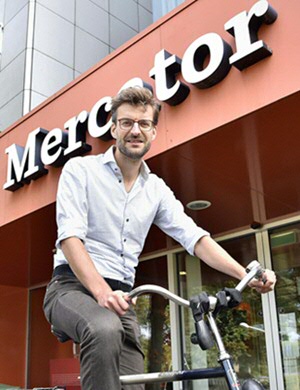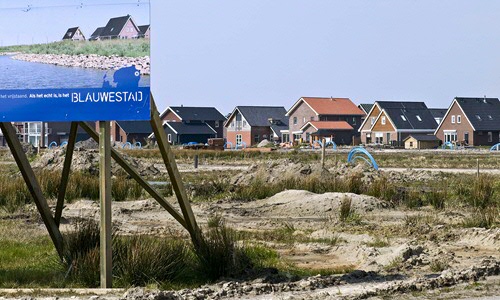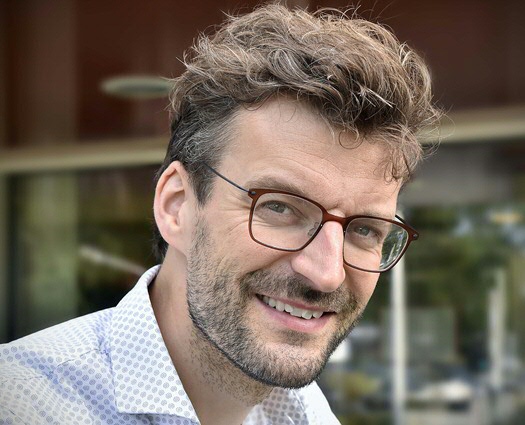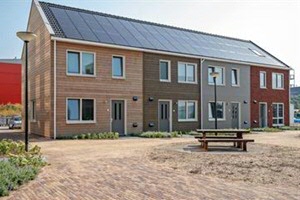Cities are in need of a makeover

Our cities are at a tipping point, states urban planner Ward Rauws: climate change, the loss of biodiversity and enormous energy consumption are forcing us to reconsider the design of our cities. The past shows us that this has happened before, for example during the rise of cities as centres of production in the industrial revolution, but also after World War Two when modern cities began to expand with the advent of cars, high-rise buildings and top-down spatial planning. In the next stage, suburban life was added to the mix. The way we use and design cities has fundamentally changed, time and time again.
Text: Martin Althof, Communication UG, photos Rauws: Elmer Spaargaren
So what is driving change now? Rauws claims that cities have become imbalanced; our way of building, how we live and how we move around, have resulted in a tremendous ecological footprint and mountains of waste are removed from cities on a daily basis. At the same time, the divide between rich and poor is rapidly growing, making good housing and the option of living in a nice neighbourhood inaccessible to some. In short, city growth comes at a very high price.
Constant alterations
Rauws believes that cities are in need of a major overhaul. He wonders what role urban planners have in directing this change. ‘In my opinion, cities are complex and adaptive systems. Complex due to the lack of central coordination. The behaviour of all residents and users collectively determines the course and can be compared to an ants’ nest. Cities are adaptive because they are open systems, extremely sensitive to outside influences: from technological developments, to changing societal preferences or even COVID-19. Cities must adjust and adapt to changing circumstances constantly. Cities are not construction sets but rather can be understood as a range of possibilities. This means constant alterations are required’.

The time factor
Rauws invites everyone to view urban development as an organic process, with both deliberate and unconscious contributions of residents, entrepreneurs, investors and developers. The government does have a unique role to play in determining the framework without having full control. To illustrate, Rauws offers several examples from the city of Groningen. ‘The reintroduction of the tram was a project spanning many years. The tram was ready for departure at the Grote Markt, so to speak. But then the political context changed and the tram never took off. The plans for the new neighbourhood Meerstad had been fleshed out in detail: a highly ambitious plan with 600 new homes per year but an economic crisis threw a spanner into the works. Changes were required, and Meerstad is now being completed in stages’. ‘Time plays an essential role in these plans, Rauws concludes. In the design process, there should be more focus on time. As time goes by, lots of things can happen. Take the development of seaport Eemshaven for example, which blossomed from a total disaster into a prime location with strong appeal. Another example is the village Blauwestad, an original idea that initially failed in its execution but now, many years later, is on the road to becoming a success story’.
Translating a vision
Blauwestad was the result of a vision: spacious living, on the water, in green surroundings and a lot of house and land for a good price. The area was initially constructed with the intention of attracting high-income households from other parts of the country to give the region a much-needed boost. But those people never came and Blauwestad remained empty. The plan of Blauwestad was like a construction set. Every last detail had been carefully planned, from the infrastructure, to the plots, the type of houses and strict demands on the design. Rauws: ‘Don’t get me wrong, a persuasive vision is very much needed, even if only to connect people and trigger the desired change. But the question is, how do you translate this vision? Leaving some wiggle room and allowing for a change of course in another direction than initially envisioned is absolutely essential’.

Adopt rule-based planning
The Netherlands has a long tradition of believing in the malleability of society and detailed zoning plans. Rauws states that this has got us to where we are today, but we are now living in a day and age where changes can occur at a rapid pace. In this context, he recommends that the rules should be formulated more with a focus on desired qualities and results. For example, a neighbourhood with low noise production, with a green look or a design that promotes meeting and interaction. According to Rauws, the answers to the question of how to achieve these goals are not set in stone. ‘This boosts creativity, and offers scope for things that had not been foreseen at the start. My advice therefore is: avoid focusing on the end result and set basic rules within action can be taken instead. Decide for example that a new residential area must generate its own electricity. How developers and residents go about realising this requirement is up to them’.

Integrate temporality in construction
Rauws emphasises that our wishes and needs in regards to how we work, live and spend our free time are in a constant state of flux, which is why he calls on urban planners and architects to integrate temporality in construction design. Rauws: ‘Container dwellings may be an off-putting prospect, but they do offer tremendous flexibility. New techniques show that flexibility need not have a negative effect on quality. Take the pop-up area at the Suikerunieterrein, which exemplifies circular building using wood and reusing materials’.
Coronavirus: bizarre and illuminating
Rauws has watched the coronavirus crisis unfold with amazement and compares it to a lab setting of sorts, in which priorities have shifted and the quality of the public space for example has become much more important. Taking a stroll in your own neighbourhood and birthdays at the park. Quieter streets due to less traffic. At the same time theatres remained empty, festivals were cancelled, bars closed and football matches were held without an audience. Fewer meetings too and a reduction in the exchange of ideas and the resulting erosion of social life.
Accelerated transformation
Predicting which effects will be lasting is difficult. After the Spanish flu of 1918, sewage systems were rapidly constructed and 9/11 resulted in permanent new security measures. Rauws believes that COVID-19 will serve as a constant reminder of how important it is to enjoy time spent outdoors, especially closer to home. Rauws: ‘This realization can expedite the transformation of cities into areas conducive to walking and cycling. I would also like to see more attention to quality of life in neighbourhoods and districts as those deserve the same attention as the Grote Markt. The action radius of children and senior citizens is limited and the neighbourhood is their whole world. We have also discovered the convenience of home deliveries. The result is new challenges with regard to sustainability and innovation of urban logistics’.
Green in Groningen
Rauws identifies a considerable amount of uncertainty about the future. Society must remain alert and be prepared to adapt. For example, he has concerns about the situation in terms of greenery in the city of Groningen. Particularly with a view to the march of climate change, that leads to heat stress and flooding. Rauws: ‘On warm days, the temperature at the Grote Markt is 8 degrees higher than at the Martinikerkhof’! He says that on this theme the strength of residents’ initiatives shows: neighbourhood gardens, more greenery in the streets, collaborations to revamp the public space. An added bonus is that these activities promote interaction. ‘It shows that residents can also take the lead in changing the city. Of course, that does not give the government licence to shirk responsibility. Instead, proactive partnerships are needed to prepare the city of Groningen for the future’.
Contact
More news
-
01 December 2025
The power of movement
-
24 November 2025
RUG en Ministerie van I&W starten brede meerjarige samenwerking
